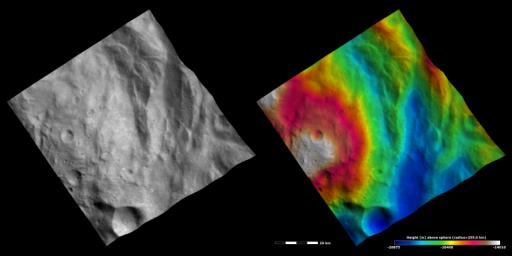These Dawn FC (framing camera) images show part of Rheasilvia quadrangle in Vesta's southern hemisphere. The left image is an albedo image, which is taken directly through the clear filter of the FC. Such an image shows the albedo (eg. brightness/ darkness) of the surface. The right image uses the same albedo image as its base but then a color-coded height representation of the topography is overlain onto it. The topography is calculated from a set of images that were observed from different viewing directions, allowing stereo reconstruction. The various colors correspond to the height of the area. The white and red areas in the left of the image are the highest areas and the blue area in the right of the image is the lowest area. The area denoted by the roughly circular white and red areas is the central complex feature of Vesta's Rheasilvia basin. The high relief of the central complex is much clearer in the topography image than in the albedo image. Also clear in the topography image is the hummocky terrain, which surrounds the central complex feature. This is an undulating terrain, which consists of ridges and grooves. The height differences between the ridges and grooves are clear in the topography image: the grooves are low and colored blue and the ridges are high and colored green, yellow and red.
These images are centered in Vesta's Rheasilvia quadrangle and the center latitude and longitude of the image is 73.4°S, 297.0°E. NASA's Dawn spacecraft obtained this image with its framing camera on October 25th 2011. This image was taken through the camera's clear filter. The distance to the surface of Vesta is 700 km and the image has a resolution of about 60 meters per pixel. This image was acquired during the HAMO (High Altitude Mapping Orbit) phase of the mission. The images are lambert-azimuthal map projected.
The Dawn mission to Vesta and Ceres is managed by NASA's Jet Propulsion Laboratory, a division of the California Institute of Technology in Pasadena, for NASA's Science Mission Directorate, Washington D.C. UCLA is responsible for overall Dawn mission science. Dawn's VIR was provided by ASI, the Italian Space Agency and is managed by INAF, Italy's National Institute for Astrophysics, in collaboration with Selex Galileo, where it was built.
More information about Dawn is online at http://www.nasa.gov/dawn and http://dawn.jpl.nasa.gov.

 Planetary Data System
Planetary Data System












